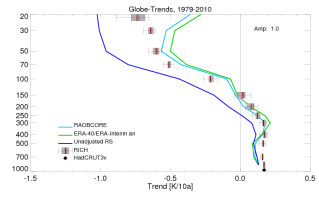RAOBCORE/RICH Version 1.5.1
December 2015, Update June 2022

The RAOBCORE/RICH software package has been developed at University of Vienna since 2004. It has been initially funded by an EU Marie Curie fellowship for Dr. Leopold Haimberger and has then been funded by four FWF projects and EU FP7 collaborative projects ERA-CLIM and ERA-CLIM2. It has been used to adjust radiosonde temperatures before assimilation in the ERA-Interim and ERA5 reanalyses. Further development is funded by the Copernicus Climate Change Service. Since 2015 it has been updated several times, the links below point to the most recent updates. For RICH, only one realization is provided in the later updates.
Comprehensive radiosonde/PILOT temperature and wind archive on 16 standard pressure levels
Within the framework of EU-project ERA-CLIM, a comprehensive radiosonde/PILOT wind archive has been developed. It can be accessed via PANGAEA (http://doi.pangaea.de/10.1594/PANGAEA.823617) over their standardized portal. The archive does not yet contain homogeneity adjustments.
RAOBCORE
One is to use again the background forecasts as reference. This has been done in the RAOBCORE homogenization method.
The current version of radiosonde temperature adjustments is v1.5.1 It basically consists of a single ASCII-file containing the stationIDs and all the adjustments and adjustment dates on 16 pressure levels for 00GMT and 12GMT. The adjustments can be added to the original datasets to yield homogenized time series.
A RAOBCORE- v1.5 adjusted temperature anomaly dataset with 10x5 degree resolution can be downloaded via https://webdata.wolke.img.univie.ac.at/haimberger/v1.5.1/
The directory contains updates until 2017, where raobcore_15_gridded_... are the right files (in netCDF format). The directory contains also the raw gridded data (raobcore_raw_gridded_...) without adjustments.
The latest updates can be downloaded from https://webdata.wolke.img.univie.ac.at/haimberger/v1.9/
RICH
Using the background forecasts as reference has the disadvantage that the forecasts themselves may be influenced by biases in the radiosonde temperatuers. They may also be influenced by biases from other observing systems, most notably satellites. This problem can be avoided by creating reference series from neighboring radiosonde stations for breakpoint adjustment. This works well as long as the radiosonde network is not too sparse and as long one takes care that only homogeneous pieces of the neighboring time series are used. RICH is superficially documented in Haimberger, Tavolato and Sperka (2008). A more detailed documentation can be found at Haimberger et al. (2012)
A gridded NetCDF formatted RICH-adjusted radiosondet dataset can be downloaded from the same directory as above. The file name patterns are rich15obs_mean_gridded...
The whole RICH ensemble, as described in can be downloaded via https://webdata.wolke.img.univie.ac.at/haimberger/v1.5.1/ens/ .
The latest updates (v1.9) can be downloaded from https://webdata.wolke.img.univie.ac.at/haimberger/v1.9/
Other formats of RAOBCORE- and RICH adjusted data
Station time series with monthly and daily resolution are available on request from leopold.haimberger(at)univie.ac.at
Selected Publications
- Haimberger, L., C. Tavolato and S. Sperka, 2012: Homogenization of the global radiosonde dataset through combined comparison with reanalysis background series and neighboring stations. J. Climate 25, 8108–8131
- Ladstädter, F., Steiner, A. K., Foelsche, U., Haimberger, L., Tavolato, C., and Kirchengast, G., 2011: An assessment of differences in lower stratospheric temperature records from (A)MSU, radiosondes, and GPS radio occultation, Atmos. Meas. Tech., 4, 1965-1977, doi:10.5194/amt-4-1965-2011
- Mayer, M., and Haimberger, L., 2011. Poleward atmospheric energy transports and their variability as evaluated from ECMWF reanalysis data. Journal of Climate, in press. [pdf]
- Haimberger, L., C. Tavolato and S. Sperka, 2008: Towards elimination of the warm bias in historic radiosonde temperature records - some new results from a comprehensive intercomparison of upper air data, J. Climate 21, 4587-4606.
- Santer, B., P. Thorne, L. Haimberger, K. Taylor, T. Wigley, J. Lanzante, S. Solomon, M. Free, P. Gleckler, P. Jones, T. Karl, S. Klein, C. Mears, G. Schmidt, D. Seidel, S. Sherwood, and F. Wentz, 2008: Consistency of modelled and observed temperature trends in the tropical troposphere. Int. J. Climatol., 28,
- Haimberger, L., 2007: Homogenization of radiosonde temperature time series using innovation statistics. J. Climate 20, 1377-1403.
